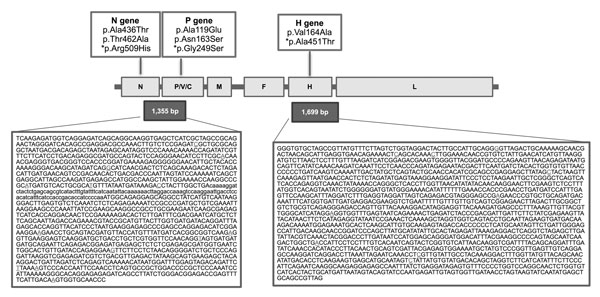Volume 22, Number 2—February 2016
Dispatch
Mediterranean Fin Whales (Balaenoptera physalus) Threatened by Dolphin MorbilliVirus
Figure 2

Figure 2. Genomic organization of the dolphin morbillivirus (GenBank accession no. KR337460) isolated from a newborn fin whale found stranded on Elba Island, Italy, October 2013. Boxes in first row indicate amino acid changes identified in each gene; asterisks indicate nonsynonymous amino acid substitutions. Boxes in the second row indicate the morbillivirus gene structure; horizontal lines indicate noncoding sequences. Boxes in the third row indicate the total length of the 2 analyzed virus fragments, and their sequences are shown, respectively, in boxes in the bottom row. N, nucleoprotein gene; P/V/C, phosphoprotein gene with nonstructural proteins V and C; H, hemagglutinin gene; F, fusion gene; L, large protein gene. Primers DMV-N1 and DMV-P2 (11) were used to amplify a 1,355-bp nt sequence (left box in bottom row) representing partial portion of N gene and P/V/C gene (shown in uppercase letters); lowercase letters indicate noncoding sequences. Three overlapping primer pairs were used to amplify a 1,699-bp nt sequence (right box in bottom row) representing the entire H gene. Underlined bases indicate nucleotide variations from the complete DMV sequence (GenBank accession no. AJ608288). The distribution of amino acid changes identified in each gene are shown in the top row.
References
- Bérubé M, Aguilar A, Dendanto D, Larsen F, Notarbartolo di Sciara G, Sears R, Population genetic structure of North Atlantic, Mediterranean Sea and Sea of Cortez fin whales, Balaenoptera physalus (Linnaeus 1758): analysis of mitochondrial and nuclear loci. Mol Ecol. 1998;7:585–99. DOIPubMedGoogle Scholar
- Panigada S, Pesante G, Zanardelli M, Capoulade F, Gannier A, Weinrich MT. Mediterranean fin whales at risk from fatal ship strikes. Mar Pollut Bull. 2006;52:1287–98. DOIPubMedGoogle Scholar
- Pinzone M, Budzinski H, Tasciotti A, Ody D, Lepoint G, Schnitzler J, POPs in free-ranging pilot whales, sperm whales and fin whales from the Mediterranean Sea: influence of biological and ecological factors. Environ Res. 2015;142:185–96.PubMedGoogle Scholar
- Castellote M, Clark CW, Lammers MO. Acoustic and behavioral changes by fin whales (Balaenoptera physalus) in response to shipping and airgun noise. Biol Conserv. 2012;147:115–22. DOIGoogle Scholar
- Van Bressem MF, Duignan PJ, Banyard A, Barbieri M, Colegrove KM, De Guise S, Cetacean morbillivirus: current knowledge and future directions. Viruses. 2014;6:5145–81.PubMedGoogle Scholar
- Casalone C, Mazzariol S, Pautasso A, Di Guardo G, Di Nocera F, Lucifora G, Cetacean strandings in Italy: an unusual mortality event along the Tyrrhenian Sea coast in 2013. Dis Aquat Organ. 2014;109:81–6. DOIPubMedGoogle Scholar
- Di Guardo G, Di Francesco CE, Eleni C, Cocumelli C, Scholl F, Casalone C, Morbillivirus infection in cetaceans stranded along the Italian coastline: pathological, immunohistochemical and biomolecular findings. Res Vet Sci. 2013;94:132–7. DOIPubMedGoogle Scholar
- Mazzariol S, Marcer F, Mignone W, Serracca L, Goria M, Marsili L, Dolphin Morbillivirus and Toxoplasma gondii coinfection in a Mediterranean fin whale (Balaenoptera physalus). BMC Vet Res. 2012;8:20. DOIPubMedGoogle Scholar
- Profeta F, Di Francesco CE, Marsilio F, Mignone W, Di Nocera F, De Carlo E, Retrospective seroepidemiological investigations against Morbillivirus, Toxoplasma gondii and Brucella spp. in cetaceans stranded along the Italian coastline (1998–2014). Res Vet Sci. 2015;101:89–92. DOIPubMedGoogle Scholar
- Yang WC, Pang VF, Jeng CR, Chou LS, Chueh LL. Morbilliviral infection in a pygmy sperm whale (Kogia breviceps) from Taiwanese waters. Vet Microbiol. 2006;116:69–76. DOIPubMedGoogle Scholar
- Bellière EN, Esperón F, Sánchez-Vizcaíno JM. Genetic comparison among dolphin morbillivirus in the 1990–1992 and 2006–2008 Mediterranean outbreaks. Infect Genet Evol. 2011;11:1913–20 .PubMedGoogle Scholar
- Ohishi K, Ando A, Suzuki R, Takishita K, Kawato M, Katsumata E, Host-virus specificity of morbilliviruses predicted by structural modeling of the marine mammal SLAM, a receptor. Comp Immunol Microbiol Infect Dis. 2010;33:227–41. DOIPubMedGoogle Scholar
- Blixenkrone-Møller M, Bolt G, Jensen TD, Harder T, Svansson V. Comparative analysis of the attachment protein gene (H) of dolphin morbillivirus. Virus Res. 1996;40:47–55. DOIPubMedGoogle Scholar
- Mazzariol S, Peletto S, Mondin A, Centelleghe C, Di Guardo G, Di Francesco CE, Dolphin morbillivirus infection in a captive harbor seal (Phoca vitulina). J Clin Microbiol. 2013;51:708–11. DOIPubMedGoogle Scholar
- Sattler U, Khosravi M, Avila M, Pilo P, Langedijk JP, Ader-Ebert N, Identification of amino acid substitutions with compensational effects in the attachment protein of canine distemper virus. J Virol. 2014;88:8057–64. DOIPubMedGoogle Scholar